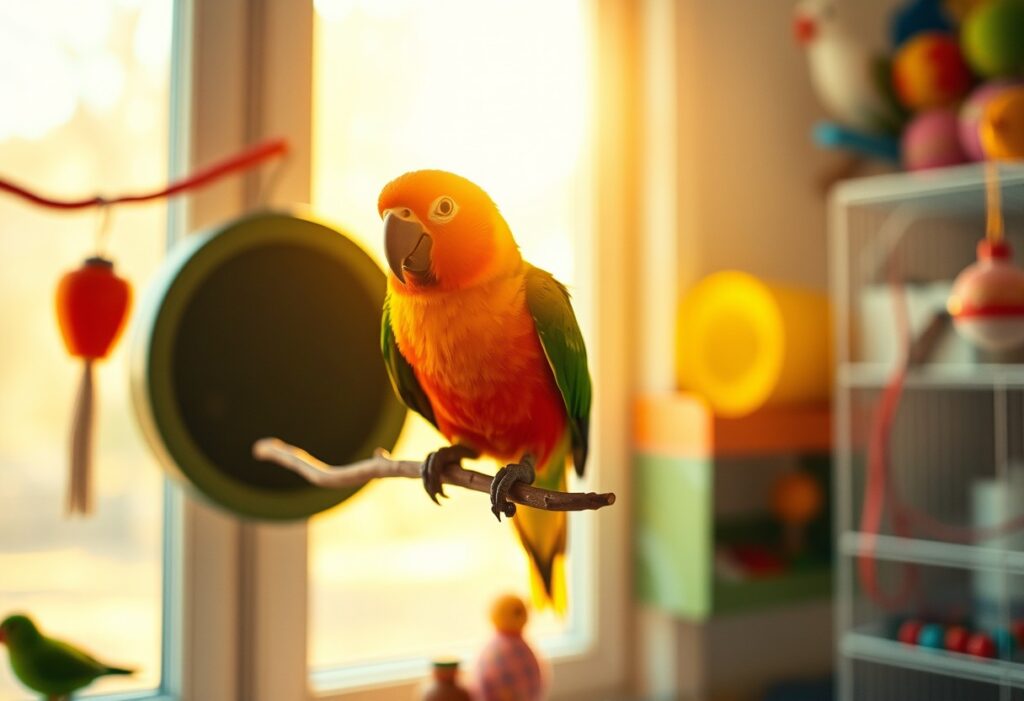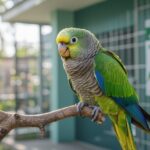Exposure to natural sunlight is crucial for your bird’s health and well-being. Not only does it help in the synthesis of imperative vitamin D, which is vital for calcium absorption, but it also promotes better mood and physical activity. Insufficient sunlight can lead to serious health issues such as metabolic bone disease. To ensure your feathered friend thrives, consider providing safe sunbathing opportunities to enhance their overall quality of life.


The Role of Sunlight in Bird Health
Before delving into the specifics of how sunlight impacts bird health, it is crucial to understand that exposure to natural sunlight plays an integral role in various biological processes. The physiological benefits of sun exposure cannot be overstated, as they contribute to overall well-being and vitality in your feathered companions.
Vitamin D Synthesis
To maintain optimal health, your birds need sufficient amounts of vitamin D, which is primarily synthesized through their skin upon exposure to sunlight. This vitamin is vital for calcium absorption, which supports strong bones and encourages healthy feather growth. Without adequate sunlight, your birds may experience deficiencies that can lead to severe health issues, such as weakened bones and stunted growth.
To further emphasize the significance of sunlight in vitamin D synthesis, consider that indoor birds—those who may not have the opportunity to bask in the sun—can rely on UVB light from specialized bulbs designed to mimic natural sunlight. This setup is crucial for pet birds that are kept indoors, allowing you to provide them the necessary exposure that they may lack in their environment.
Feather Maintenance
With regular sunlight exposure, your birds can maintain their feathers in optimal condition. Sunlight not only contributes to the physical health of your birds, but it also plays a crucial role in maintaining the integrity and luster of their plumage. When exposed to sunlight, birds tend to groom themselves more often, which helps to prevent feather loss and keeps their feathers clean and healthy.
Understanding the connection between sunlight and feather maintenance leads you to appreciate how sunlight facilitates the natural oils that coat your bird’s feathers. These oils protect against water damage and keep feathers flexible, ensuring that your bird is both comfortable and perfectly equipped for flight. Without proper sunlight exposure, your birds may face issues like dry, brittle feathers that can lead to complications such as feather plucking or uneven molting.
Immune System Support
Synthesis of vitamin D is also crucial for the robust functioning of the immune system in your birds. Birds that receive adequate sunlight exposure tend to have stronger immune responses, allowing them to fend off diseases more effectively. When your feathered friends bask in the sun, they are not only enhancing their vitamin D levels but also fortifying their overall immunity, promoting resilience against infections.
For instance, studies have shown that birds that experience regular sunlight exposure tend to have lower rates of respiratory infections and other ailments. By ensuring that your pet birds have access to acceptable sunlight, you are proactively supporting their immune system, which can result in fewer vet visits and a happier, healthier pet.
Behavioral Benefits of Sunlight Exposure
Clearly, sunlight exposure plays a crucial role in the behavioral health of birds. Direct sunlight not only influences their physical well-being but also significantly impacts their social dynamics. When birds spend time basking in the sun, they derive numerous benefits that enhance their overall behavior and interactions with others in their species. This natural light stimulates their energy levels and fosters a variety of activities that are imperative for both their survival and social bonding.
Increased Activity Levels
For many bird species, exposure to sunlight is associated with heightened activity levels. Sunlight can stimulate your birds’ metabolic processes, which in turn encourages them to engage in more vigorous behaviors such as foraging, flying, and exploring their environment. This increase in activity is vital as it helps maintain a healthy weight and encourages muscle development, making your birds agile and strong. A lack of adequate sunlight can lead to lethargy and even obesity, creating a more sedentary lifestyle that doesn’t support their natural instincts.
Moreover, birds with sufficient sunlight exposure often display more vibrant and lively behaviors. You may notice that your feathered friends become more curious, play more, and engage in social interactions when they’re basking in the sun. These behaviors are not only enjoyable for you to observe but are also imperative for their cognitive development and emotional health.
Enhanced Mating Displays
Enhanced mating displays in birds are frequently associated with their ability to access sunlight. Exposure to bright, natural light plays a significant role in promoting the rich, vivid plumage that is imperative for attracting mates. During mating season, well-lit environments allow males to exhibit their colors and patterns, making them more appealing to potential partners. This phenomenon underscores the idea that adequate sunlight is crucial for maintaining the physical condition that influences reproductive success in birds.
Another factor is that courtship rituals often flourish with increased sunlight exposure. You may notice that your birds perform elaborate displays, such as singing, dancing, or showing off their feathers, when they have the opportunity to bask in the sun. These behavioral expressions are not just for show; they are key components in establishing territory and attracting mates, which directly impacts your birds’ reproductive success.
Social Interactions
Behavioral dynamics within avian social groups are significantly influenced by sunlight exposure. Birds that receive ample sunlight are more likely to develop strong social bonds and engage in cooperative behaviors. When you observe your birds basking together, they are not only enjoying the warmth but also reinforcing social structures that are crucial for their well-being. The presence of sunlight can create a calm and inviting atmosphere, promoting interactions that enhance social cohesion.
Levels of social interaction can also be heightened when birds exhibit increased energy levels and enhanced mating displays, as previously mentioned. You may witness more vocal communication and playful interactions among your birds during sunny periods, further emphasizing the importance of sunlight in their social lives. These interactions not only strengthen their relationships but also play a role in their overall behavioral health, creating a more harmonious living environment for them and enriching your experience as an avian caretaker.

Environmental Factors Affecting Sunlight Exposure
Many factors influence the availability of sunlight for birds in their habitats. This access to sunlight is crucial for their survival, as it affects their foraging behavior, breeding, and overall health. Recognizing how diverse environmental changes impact birds can guide conservation efforts. Here are some key environmental factors:
- Habitat Destruction
- Urbanization
- Seasonal Changes
Habitat Destruction
Factors such as logging, agriculture, and mining contribute significantly to habitat destruction, leading to reduced sunlight exposure in many regions. When forests are cleared or wetlands are drained, critical areas where birds thrive become fragmented. This fragmentation not only reduces the area available for birds to seek shelter and forage but also limits their access to direct sunlight. The consequences can be dire, often resulting in decreased breeding success and increased mortality rates among bird populations.
Furthermore, habitat destruction can lead to a loss of important native vegetation that provides both food and cover for birds. Many species depend on specific plants to thrive, and without adequate sunlight reaching these plants, their health is compromised. This loss can trigger a domino effect, threatening entire ecosystems. It is important to prioritize conservation efforts to protect these vital habitats, ensuring that birds can enjoy sufficient sunlight exposure.
Urbanization
To understand how urbanization impacts sunlight exposure for birds, consider that the development of cities creates numerous barriers. Urban areas are often characterized by large buildings, which block natural light and lead to limited access to the sun for local bird species. This phenomenon is particularly concerning as it diminishes the natural behaviors of birds, such as foraging and nesting. With fewer spaces to bask in sunlight, birds may face difficulties maintaining their health and reproductive success.
Additionally, urban settings frequently alter local climates, creating “heat islands” where temperatures are artificially elevated. This change can disrupt natural migration patterns and breeding cycles among birds, as their need for sunlight becomes exaggerated in such environments. Sunlight is crucial for regulating important behaviors, and when its availability is compromised, the ramifications can be severe. You can help by supporting urban green spaces that provide natural habitats for birds, which can mitigate some negative effects of urbanization.
Sunlight availability can significantly shift throughout the year due to seasonal changes. Habitat degradation can further exacerbate the challenges birds face in finding adequate sunlight, especially during critical breeding seasons. If plant life suffers, the reduced photosynthesis can lead to less energy available for bird food sources, which rely on direct sunlight for growth. Therefore, changing seasons can greatly impact the availability of light and resources.
Seasonal Changes
Habitat variety changes with the seasons, affecting not only the birds’ exposure to sunlight but also their overall behavior. During winter, shorter days and reduced sunlight can affect your birds’ feeding habits and reproductive cycle, leading to increased competition for resources. Conversely, during spring and summer, longer days provide birds with increased opportunity for foraging and mating, especially in areas where sunlight is abundant.
It’s important to recognize that different species have adapted to varying levels of seasonal sunlight and temperature. These adaptations are what keep ecosystems in balance; without seasonal shifts, you could see disruptions in breeding and feeding patterns that could jeopardize bird populations. Awareness of these environmental factors can ultimately help you appreciate the delicate balance necessary for bird survival.
Perceiving the intricacies of environmental changes can strengthen your understanding of avian ecology, enlightening the path toward more harmonious living with bird populations.
Summing Up
With these considerations, you can appreciate the crucial role sunlight exposure plays in the overall health and well-being of your birds. Proper sun exposure not only helps in synthesizing imperative vitamins, such as Vitamin D, but also supports behavioral health by mimicking their natural environment. By allowing your birds to bask in sunlight, you foster their physical vitality, enhance their mood, and promote activities that imitate their natural instincts, leading to a more enriched life.
It’s important to remember that moderation is key when it comes to sunlight exposure. Too much sun can lead to overheating or sunburn, while too little can cause deficiencies and related health issues. By providing a balanced approach to sunlight exposure, you not only ensure optimal health but also create a stimulating environment where your feathered friends can thrive. Remember to observe your birds closely, adjust their sun exposure as needed, and consult with a veterinarian for guidance to keep them in peak condition.
FAQ
Q: Why is sunlight exposure important for birds?
A: Sunlight exposure is vital for birds as it contributes to their overall health and well-being. Sunlight helps birds synthesize vitamin D, which is imperative for calcium absorption and bone health. Without adequate sunlight, birds can suffer from deficiencies that lead to various health issues, such as metabolic bone disease. Additionally, natural sunlight influences their behavioral patterns, breeding cycles, and immune function, promoting a better quality of life.
Q: How much sunlight do pet birds need daily?
A: Pet birds typically need around 2 to 4 hours of direct sunlight exposure each day. However, this can vary depending on the species and their specific environmental needs. For optimal health, it’s best to provide them with natural sunlight whenever possible, but this should be balanced with shaded areas where they can retreat if they become too warm. If natural sunlight is not feasible, using full-spectrum bird lights can simulate sunlight and help provide necessary UVB rays for their health.
Q: What are the signs of insufficient sunlight exposure in birds?
A: Birds that are not receiving adequate sunlight exposure may exhibit a variety of signs indicating poor health. These signs can include lethargy, loss of appetite, feather plucking, and a dull or discolored plumage. Behavioral changes such as increased aggression or decreased vocalization may also occur. If you notice these symptoms in your bird, it’s crucial to evaluate their sunlight exposure and seek a veterinarian’s advice to ensure their health is not compromised due to lack of sunlight.










